A projectile is shot from the ground at a velocity of #6 m/s# and at an angle of #(5pi)/6#. How long will it take for the projectile to land?
1 Answer
We separate the motion into vertical and horizontal and solve for the vertical position as a function of time, finding that the object returns to the ground at
Explanation:
There are many ways to answer this question, for example, we could solve for the full equation of motion in two dimensions and then find the time for the object to complete its parabolic path:
![https://commons.wikimedia.org/wiki/File%3AFerde_hajitas2svg] ( )
)
But this is more work than we need to do. We can separate the vertical and horizontal components of the motion and treat them separately. In our case, we only care about the vertical component and we'll completely ignore the horizontal .
What we need is an expression for the vertical position of the object so that we can determine when it returns to the ground, which we'll call
where
Putting this into our equation for
If we eliminate

